
It's this simple: If you don't keep track of your competitors, you're going to lose market share to them. It's important that you monitor what other businesses in your industry are doing in order to successfully build a brand online. One way to do that is to learn about how their content marketing efforts are diving traffic.
Here are three key metrics you should monitor when evaluating the inbound marketing efforts of your competitors.
1. Social Shares
Social media is a great tool for generating buzz online. This is a fact that's not lost on competent digital marketers.
One of the best ways to track the success of your competitiors content marketing efforts is to note how many shares that content is getting on various social media channels. Determine the following:
- How many people are tweeting about the content?
- How many people are retweeting those tweets?
- How many people are sharing the content on Facebook?
- How many people are posting about it on LinkedIn?
Fortunately, the tool Buzzsumo exists for that very reason. It enables you to track the virality of a competitor's content. Simply type in the domain name of a competitor and see which content on the website is getting shared the most. You can also filter those results based on the timeframe or the type of content (articles, infographics, etc.). The app will show you a list of posts on the site and relevant social shares from Facebook, Twitter, Pinterest, LinkedIn, and Google+. Buzzsumo is free to use a limited number of times per day, or you can sign up for unlimited searches.
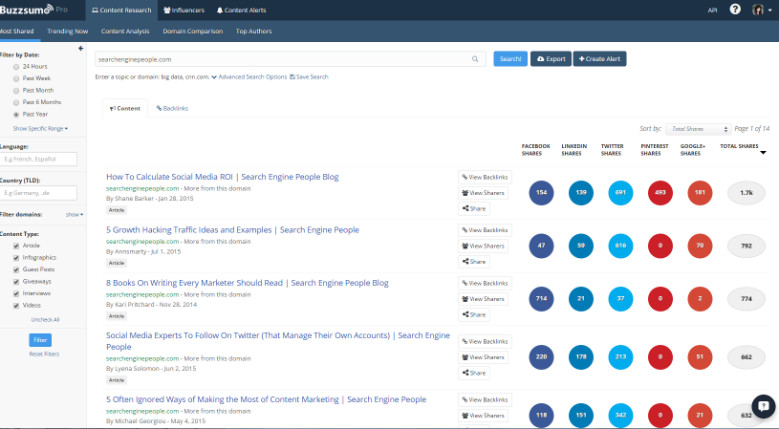
Consider also using SharedCount to track the success of specific pieces of content on your competitor's website. It's as simple to use as Buzzsumo: just plug in a domain name and the site will provide information about relevant social shares. SharedCount counts shares from a greater number of social sites than Buzzsumo, but you can only see the results for one piece of content at a time.
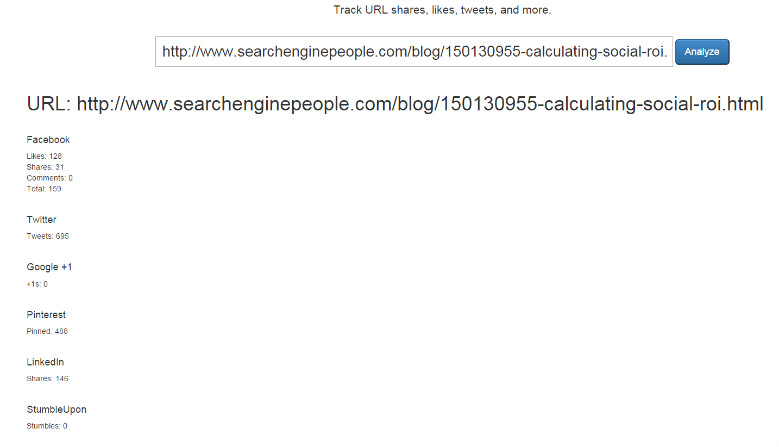
2. Links
As a content marketer, you certainly want backlinks, especially from high profile websites. You should also monitor the number of backlinks your competitors receive.
Ahrefs is an online tool that allows you to check backlinks for a specific domain. Its a pay-to-play service with just a few free uses per day, so you'll have to be committed to online marketing if you want to use it, but many digital marketers find it invaluable.
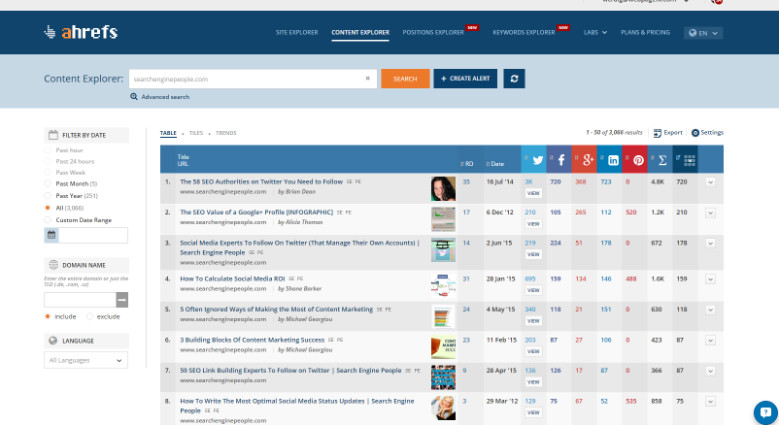
Ahrefs is also very simple to use. Just type in the domain name and select Top Content. Then, sort by root domains. What you'll likely see in the resulting report is that the home page will be at the very top, but specific pages with a lot of backlinks will jump out at you.
3. Traffic
It's difficult to tell how much traffic specific content on a competitors site is receiving. You don't have access to their analytics, after all.
It's possible, however, to get a rough estimate. Start by looking at the Alexa rankings of your competitors. That won't give you a super-accurate assessment of traffic, but it will give you an idea of the amount of traffic the site receives relative to other sites, like your own. With Alexa, it is important to remember that it is a ranking in order from the #1 site on the web (Google, naturally) and counting up from there, so the lower the number, the more traffic it likely receives.

Another site to determine traffic is Compete. Unlike Alexa, Compete gets its information from multiple sources. Also, it only uses U.S. traffic as a gauge, something you will want to keep in mind if you have a large international audience.
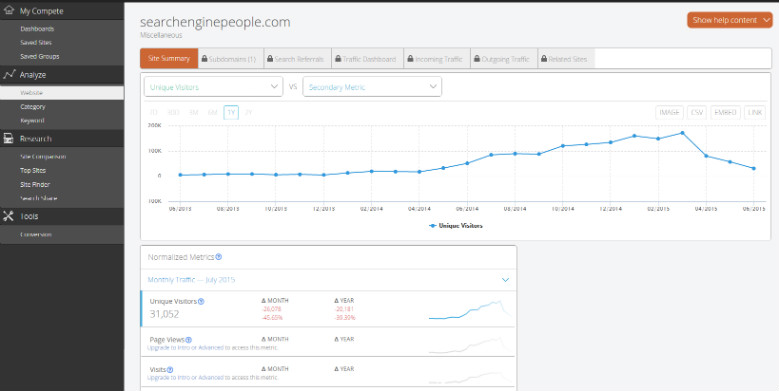
Finally, consider using SimilarWeb. It's similar to the other two options but attempts to identify other potential competitors. You will need to sign up for a free account in order to run domain reports and get traffic update notifications.
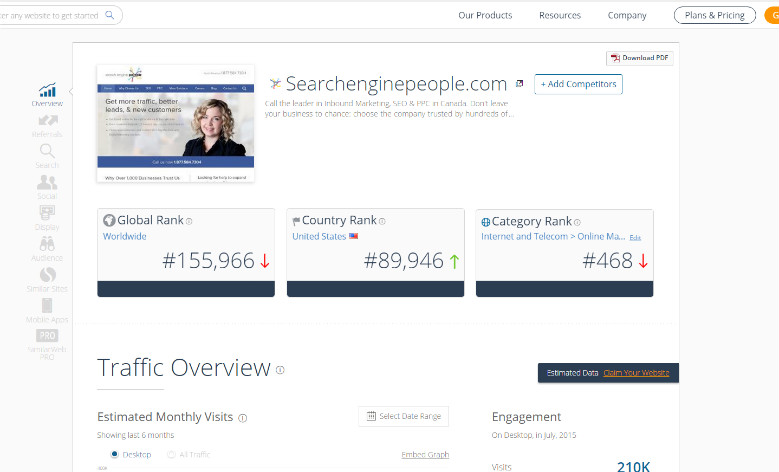
What Should You Do With All This Information?
Now that you have all this information about your competitors, what do you do with it?
For starters, use Buzzsumo and SharedCount to determine what type of content is shareable in your industry. Then, go and do likewise. Produce the same type of content on your site and you should see similar levels of sharing.
Next, find out where the competition's backlinks are coming from. Ask yourself these questions:
- Are there patterns?
- Are they from guest blogging opportunities?
- Would you be able to produce backlinks on some of those same domains?
- Would you be able to put your own backlinks on similar domains?
Also, find out what type of content is receiving the backlinks. Can you provide that type of content? Better yet, can you improve that type of content so that it's considered more valuable?
Finally, consider using your competitors backlinked content as inspiration to create your own longer-form content. If you can create similar content that has more than 1,500 words, you're likely going to see a nice jump in your search engine rankings.
Final Thoughts
If your competitors have been more successful than you in certain content marketing efforts, you would do well to imitate those successes. You'll have to monitor your competition's social sharing, backlinks and traffic to make a determination about what can be successful. Use the tools above to learn what works in your industry so you can continue to build a powerful online presence.
Now Read:
[/flowsplit]Next Steps:
[/flowsplit]Hand-Picked Related Articles:
- 9 Tips For Evaluating The Quality Of Your Site's Content vs. A Competitor
- Simple & Effective Competitive Analysis For Your SEO Campaign
- How To Use Your Competitors To Improve Your Marketing
* Leader image(s) adapted from JD Hancock, JeepersMedia
2 Comments
Comments are closed.


This is definitely a very useful article. The power of research can never be overstated–especially in this type of field. I will definitely have to look into using these tools in my future assignments.
Awesome share. These tools are the creme of the crop. I do think sometimes keeping an eye on competitors can become burdensome and take away from what a business is doing for themselves. Sometimes you have to put your head down and charge forward with your own plans – eventually competitors end up in the rear view mirror that way.